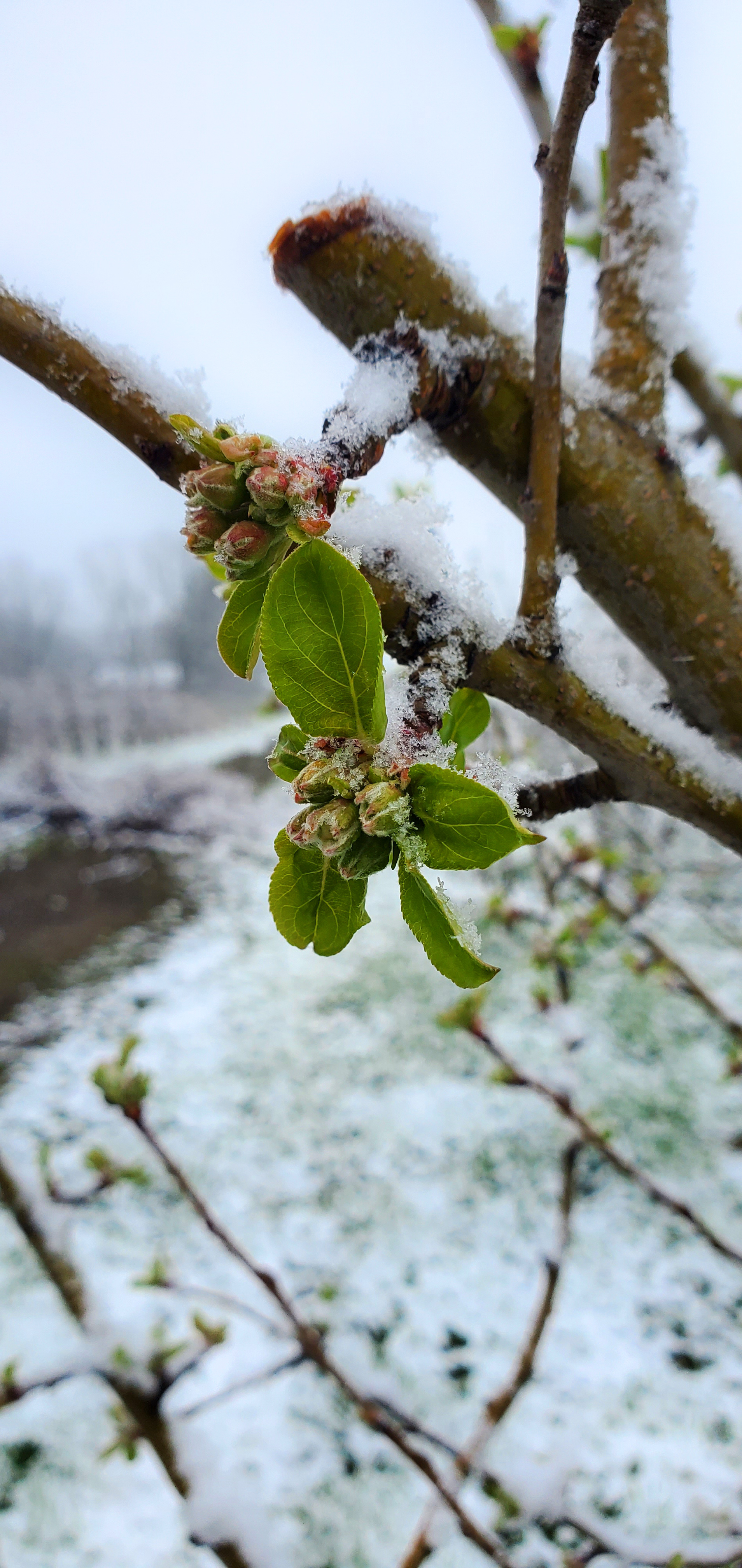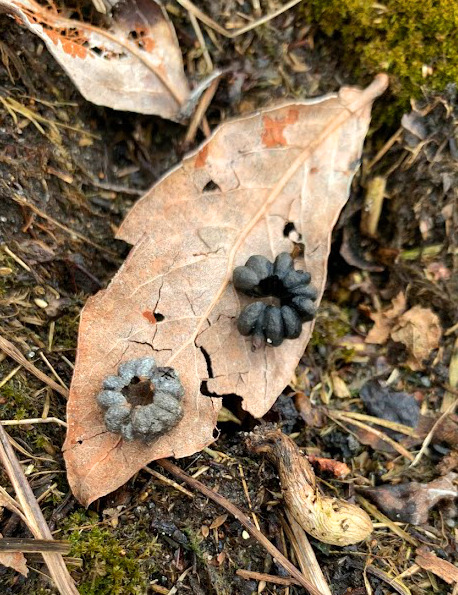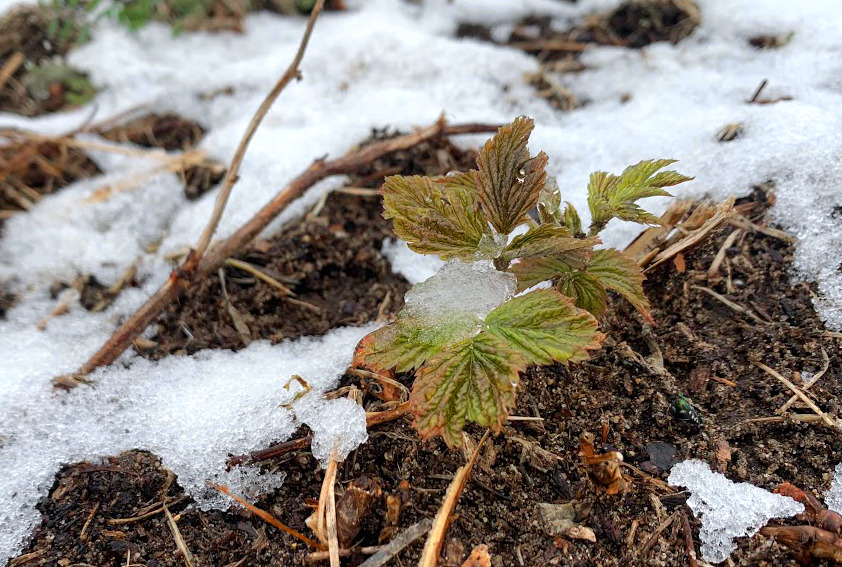Southwest Michigan fruit update – April 19, 2022
Bloom has begun in apricots. More blooming crops are expected by the end of the week.

Weather
Last week, again, started warm with high temperatures near 70 on Tuesday and Wednesday. Another mid-week storm system on Wednesday brought rain and cooler weather. Temperatures gradually dropped through the end of the week with high temperatures only near 40 on Saturday and Sunday.
A hard freeze hit much of the region early Sunday morning. Many parts of southwest Michigan saw low temperatures around 26-27 degrees. Many crops were unaffected, but some early blooming varieties may have minor damage.
Rain was recorded on Wednesday through Friday of last week with the first day being the major system rain. Another round of precipitation came through on Monday with measurable snow Monday morning and rain continuing through the afternoon. Total rainfall for the past week was 0.5 to 1 inch with heavier amounts recorded in the eastern portions of our region.
The coming week should, again, be warmer than last week. The week is starting out cold with highs in the 40s, but temperatures will rise through the week with mid-70s expected by the weekend. Lows will also rise through the week, starting near freezing and finishing in the upper 50s by Sunday. Rain is expected on Wednesday through Friday.
With the warmer week we collected more degree days than last week, 40 growing degree days (GDD) base 42, 21 GDD base 50.
|
Southwest Michigan GDD summary from March 1 – April 18, 2022 | |||
|---|---|---|---|
|
Station |
GDD 42 F |
GDD 45 F |
GDD 50 F |
|
Benton Harbor (SWMREC) |
169 |
121 |
65 |
|
Lawton (Lawton) |
174 |
129 |
72 |
|
Fennville (TNRC) |
146 |
106 |
57 |
|
Average for the SW region |
172 |
125 |
70 |
|
Average last week |
132 |
94 |
49 |
Tree fruit
The slightly warmer weather has sped up development. It is too early to see any potential damage from the freeze on April 17, 2022. Based on previous cold damage research, no significant damage is expected.
The recent wet weather has slowed down progress on pruning. Check blocks for evidence of San Jose scale on branches to determine the need for oil sprays. The window for treating trunks with pyrethroids for black stem borer has been delayed by cool conditions. Biofix for this pest may come by this weekend for the warmer parts of southwest Michigan. Oriental fruit moth biofix is also expected this weekend. Mating disruption treatments should be up before biofix for full season efficacy.

Apricot buds are at immediate pre-bloom or first bloom depending on variety and location.

Peach and nectarine are at red calyx or first pink, depending on variety. Bacterial spot survives the winter in terminal and lateral buds, and young shoots. These areas turn necrotic in the early spring and serve as inoculum sources for infecting foliage and fruit.
Low levels of copper generally help suppress bacterial spot populations. Based on the Southwest Michigan Research Extension Center’s Enviroweather station, two peach leaf curl infection periods have occurred since the start of bud swell.
In cherries, sweet cherries are at tight cluster, with some advanced trees in sheltered spots showing opening clusters. Expansion of first bract leaves (beginning of risk period for cherry leaf spot infection) for central Berrien County is estimated as April 24, 2022 (250 GDD base 42 after Jan. 1).
In plums, Japanese plums are showing first white. European plums are showing some green tips. Prune out black knot and dispose of the knots by burning or removing them from the orchard. Sanitation is an important step in managing this disease. Fungicide control generally starts at green cluster. European plum (most varieties) are more susceptible than Japanese to this disease.
Apple varieties in central Berrien County range from 0.25-inch green to early first pink. Scab sprays are needed during the primary scab season to protect against ascospores released in rains. Weather stations in southwest Michigan are showing significant differences in the number of predicted scab infection periods, with central Berrien having fewer events. Protectants are preferred over systemic fungicides at this time of year for scab control to reduce the number of systemic fungicide applications and thereby slow the development of resistance. Mancozeb fungicides are compatible with delayed dormant oil sprays which may be needed in sites battling scale. Powdery mildew and rust control generally start at pink.

Pear buds are at bud burst and require protection against scab. Be prepared for fire blight management at bloom. Oil applications at this time help with suppression of pear psylla.
Small fruit
Grape buds show small amounts of movement in juice varieties and in early hybrid wine grapes such as Marquette.
Blueberry flower buds range from swollen bud in mid Van Buren County to tight cluster in southern Berrien County. Terminal buds are open in early varieties. Green tissue is visible – around 1/8 in green in upper leaf buds. This is a good time to be scouting for mummy berry. On Wednesday, April 13, mummy berry initials were found at the Southwest Michigan Research and Extension Center, but it is unlikely there has been any spore release north of Berrien County. The window for mummy berry control should open once we get warm weather later this week. The first mummy berry control sprays could be applied before this Friday's rain. You still have time to apply copper, Sulforix or lime sulfur products to suppress early season diseases.

Strawberries have continued to green up and new leaves are emerging from the crown. Overwintering mulches should be removed and raked between the rows. Some growers are putting out floating row covers. Growers are looking at early season herbicides to control overwintering weeds. When selecting an herbicide, check the preharvest interval (PHI). Now is also a good time to be thinking about early season fungicide treatments for things like leaf spot.
Brambles show movement with buds enlarging and beginning to separate in some areas. New canes are starting to be seen in some fall bearing raspberry fields. Dormant pruning should be completed soon. In summer bearing raspberries, last year’s primocanes should be headed (cut back) to the desired height and any remaining floricanes from last year should be removed. Fall bearing raspberries should be cut or mowed to the ground soon. Lime sulfur treatments for anthracnose can still be applied.

Cranberries are still dormant and fields are red.
Currant and gooseberry leaves are opening.
Hops are beginning to develop. Early bines are up to 4 inches tall. These early bines will be removed to improve the development of the more fruitful bines later in the spring.
Upcoming meetings
Our regular Southwest Michigan Monday Fruit IPM Updates will be moving to a hybrid format. The meetings will be held in person with virtual attending also available online. You need to register to receive the Zoom link and password for these meetings. The webinars are free and two pesticide applicator credits are available for each meeting.
The 2022 Statewide Michigan Grape Kickoff Meeting will be April 29 from 9 a.m. to 5 p.m. This will be a hybrid event with in-person attendance at the Northwest Michigan Horticultural Research Center. Preregistration is required.
Related articles
- Black stem borer: An opportunistic pest of young fruit trees under stress
- 2022 Fruit insecticide registration update
- Southwest Michigan fruit update – April 12, 2022
- Southwest Michigan fruit update – 2021 review
- Freeze damage depends on tree fruit stage of development
- 2013 bloom dates for southwest Michigan tree fruit crops
- Managing bacterial canker in sweet cherries: What are the options?
- Early insect control with horticultural oils
- Scouting and management of mummy berry in blueberries
This work is supported by the Crop Protection and Pest Management Program [grant no 2021-70006-35450] from the USDA National Institute of Food and Agriculture.



 Print
Print Email
Email
